GetCalFresh
Research / Design / Development
2017 – 2018
GetCalFresh is a service that helps millions of Californians each year to put food on the table. What started out as proof-of-concept prototype was eventually adopted by the State of California as the official online application for CalFresh.
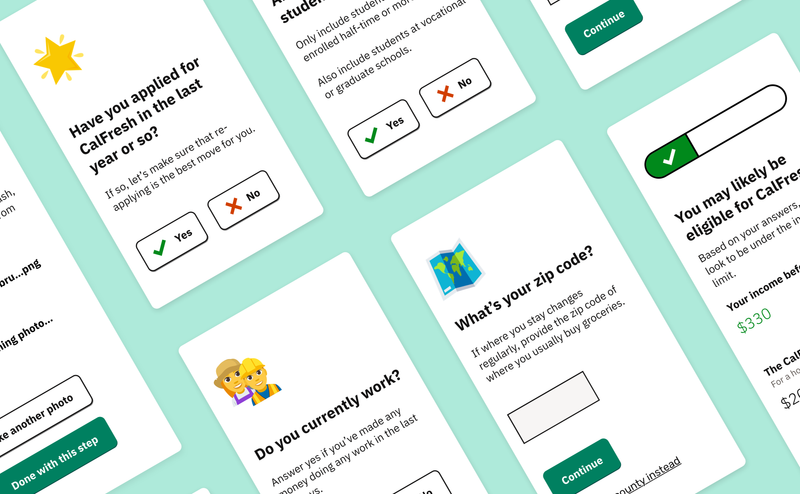
Background
In 2015, three former CfA fellows studied the experience of being on food stamps and realized if they wanted to increase the participation rate, the enrollment process would have to be fixed. As a result, they partnered with government in California to prototype a new CalFresh application.
After the success of an initial prototype, I was brought on as the first designer on the team. We decided to focus on diving deeper into the specific barriers that clients were facing.
From 2017-2018, the GetCalFresh team combined qualitative and quantitative research to understand the barriers Californians faced as they applied for CalFresh (food stamps). Based on what we learned, we redesigned the application experience, published three research reports, and helped to influence legislation in California.
Applying online was the most painful part of the process. It prevented many eligible people from accessing a service they desperately needed.
Research
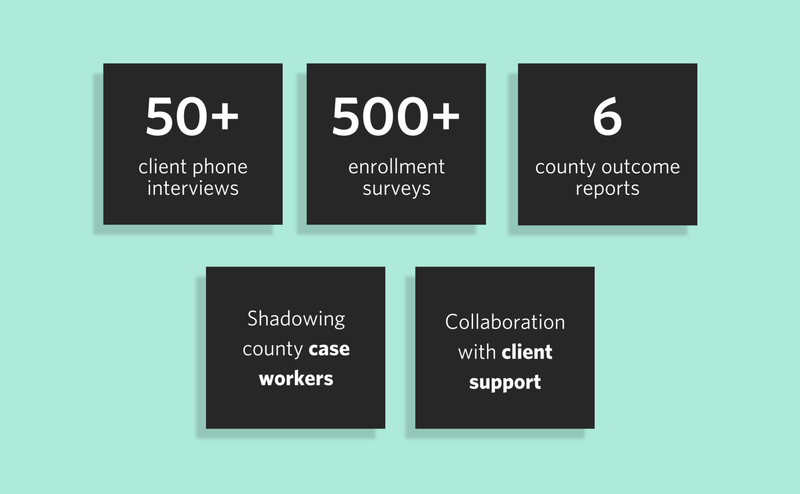
From October 2017 - January 2018, I led the research effort with data scientist, Eric. Between the both of us, we sought to understand the situation from as many angles as possible:
Eric and I found a great rhythm of “ping-ponging” between qualitative and quantitative research. Sometimes I would notice a trend in user interviews and would ask Eric if he could identify the severity of the problem through a data investigation. Sometimes Eric’s data analysis would show an issue people were having but couldn’t understand why. As a result, I would talk to a few clients to see if I could understand the reason behind it.
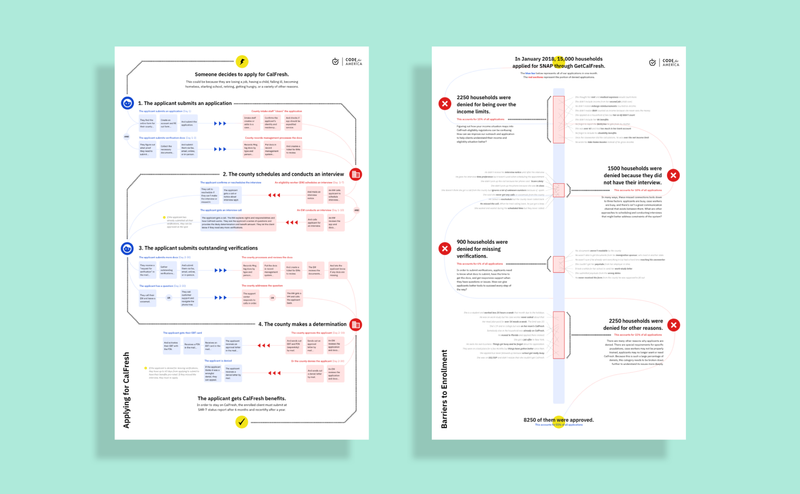
Left: a service blueprint I designed to help staff and partners understand the turn-based nature of enrollment that caused many people to abandon the process.
Right: an infographic that uses data and anecdotes to help staff and partners understand specific problems in the process and how severe they were.
Through our research, we generated three detailed reports that combined stories from user interviews with analytical evidence to help shed light on barriers in the enrollment process. These reports were shared with government and non-profit partners.
Design a Better Application
After our research, we asked ourselves, “What can we do to improve our application?”
The initial inspiration was to learn how assisters at community-based organizations worked. Through helping hundreds of people apply in-person over years, they had learned how to maximize a person’s chance of getting through the process.
We talked to helpful friends at the SF-Marin Food Bank and the Alameda Food Bank.
Based on what we learned, I started the process by finding ways to rapidly prototype a better flow.
The first was a script that I ran through with 10 clients verbally and then following up with them to see if they were approved or denied.
The second iteration was taking the questions on that script and breaking them into index cards that roughly represented the design.
The third was a high fidelity index card prototype that I reviewed with the team and with subject matter experts from local food banks.
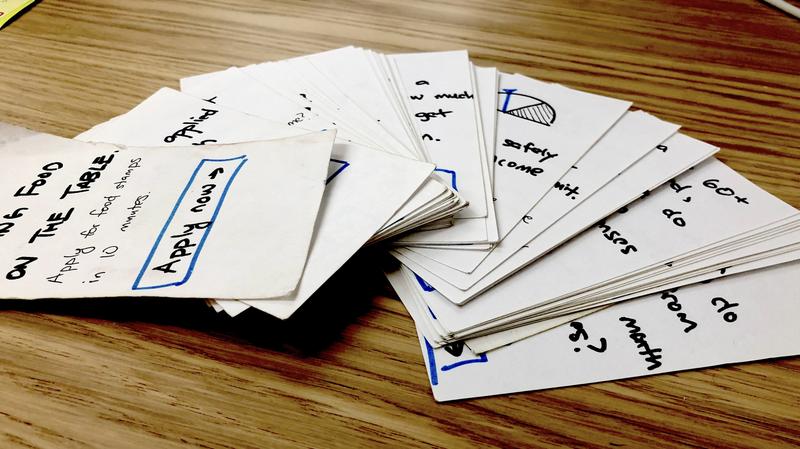
The initial index card prototype based on the questions food bank employees would ask when helping people to apply.
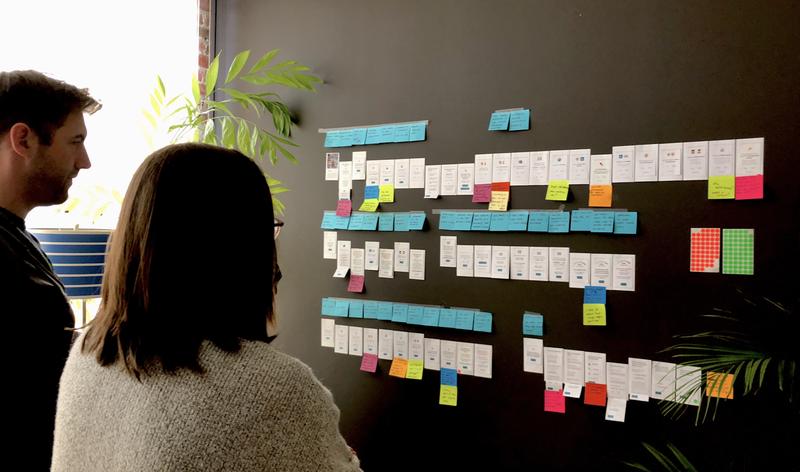
A design review session I led with food bank employees and the GetCalFresh product team.
At each step, we used feedback from clients and subject matter experts to adjust the language and flow of the application.
After feeling good about the new redesign, our product manager and I broke the redesign into smaller stories in pivotal tracker that engineers could work on over time.
Here is the final result of the new application:
What GetCalFresh looks like as of January 2019. We continue to iterate to improve the user-experience and incorporate new legislation as it is passed.
Impact
As of July 2019, over one million Californians have used our service to apply for CalFresh. We help an average of 10,000 people every week.
Before GetCalFresh, most people never even considered applying by themselves online. Today, California has a plain-language and mobile-friendly way to apply within 10 minutes. The service is designed to educate as much as it is to help them fill out a form.
Our redesign showed also impact in applications received by counties. We provided more accurate eligibility pre-screening. We measured a 60% increase in verifications submitted. These factors resulted in a 10% increase in application approval rate.
Because the flow was clearer for clients, it was also clearer for us. This more logical flow through the application has helped make future iterations much easier for our product team.
Our way of working has also helped to inspire government. The happiest moments are when we hear our government partners adopt terms like user-centric or agile development. We are commonly invited to facilitate workshops to make sure that new legislation is designed with users in mind.
While the online service is the most visible result of our work, culture change in government is what will bring the most lasting impact.
We put clients at center with stories and data, we captured challenges with client access and operations at many places in their journeys, and we teed up a new framework of solutions to be further developed and implemented. We will debrief more of course, but didn’t want to wait to say thank you and kudos on an excellent job!
– A thank you note from the director of the California Department of Social Services